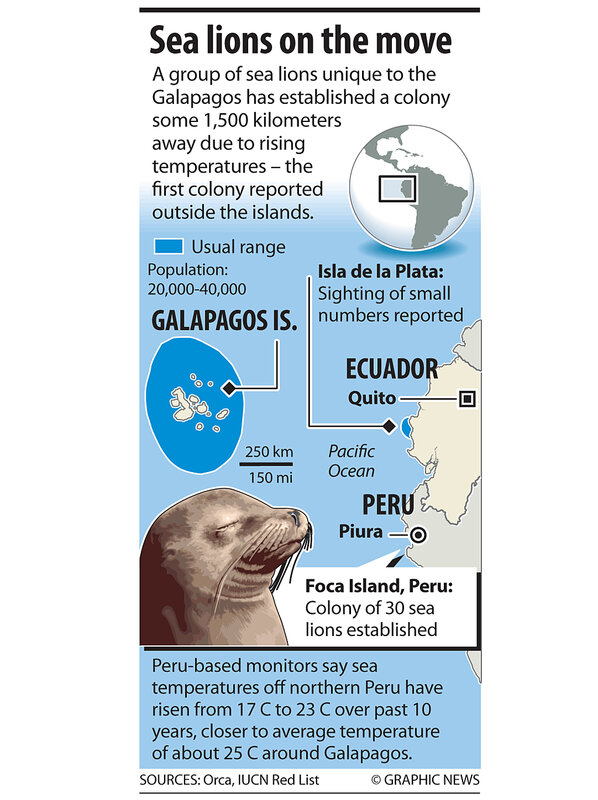Why are Galapagos sea lions moving to Peru?
Loading...
Warming ocean waters are turning the Peruvian coast into a retreat for Galapagos sea lions, according to an ocean life monitor in South America.
A colony of about 30 sea lions from Charles Darwin's old stomping ground recently migrated 1,000 miles southeast to the northern coast of Peru, the Lima-based Organization for Research and Conservation of Aquatic Animals (ORCA) recently announced. The says the sea lions migrated south because of off the coast of northern Peru, which warmed six degrees Celsius over the past decade to 23 degrees Celsius as a result of climate change, reports the BBC.
The UN Environment, Scientific and Cultural Organization (Unesco) in 2008 declared the Galapagos Islands, the world‚Äôs first World Heritage Site, ‚Äúin danger‚ÄĚ and from invasive species, increased tourism, and growing immigration.
This is the first observance of Galapagos sea lions setting up a colony outside the islands, though America’s sea lions have also headed for colder waters in recent years.
But some scientists question whether there's enough research to say the Galapagos sea lion migration ‚Äď and others like it ‚Äď is caused by climate change.
Hundreds of San Francisco’s famed sea lions in November for the Oregon coast, 500 miles north. In that case, the sea lions were in search of Oregon's abundance of anchovies.
‚ÄúMy gut feeling is it has something to do with the [ocean warming] El Nino conditions off California, which is driving prey and sea lions up north,‚ÄĚ a biologist told the Associated Press at the time.
However, biologist Michael Moore of the Woods Hole Oceanographic Institution on Cape Cod, Mass., says it is often too simplistic to blame animal migration completely on climate change.
‚ÄúCertainly climate change is part of the driving force, but it‚Äôs going to be aligned with changes of habitat quality, pollution, noise‚Ķ many things are all going to add up,‚ÄĚ Moore said by telephone Monday.
Fish migrate, Moore says, but myriad factors play into that migration and examples point toward fish moving toward both warmer and colder waters. Along the East Coast, for example, small dolphins have migrated north to colder waters even while harp seal have trended south to warmer waters.
‚ÄúIt‚Äôs so easy to say, ‚ÄėOK, climate change, here it is,‚Äô‚ÄĚ Moore says. ‚ÄúI‚Äôm not saying I don‚Äôt believe in climate change ‚Äď all you have to do is go north and the locals will laugh at you if you say you don‚Äôt believe in climate change. But to say that therefore every move is driven my climate change‚Ķit‚Äôs associated, but there are other factors.‚ÄĚ
“If you want to understand this, you have to look a lot deeper."
Aside from influencing sea and air temperatures, pollution is also increasing ocean acidity, according to a December report from the UN Convention on Biological Diversity. Seawater acidity rose 30 percent over the past 250 years, but as a result of carbon dioxide pollution it will rise 150 percent over the next 40 years, depleting the sea of carbonate minerals necessary for coral and shell-building marine life.





